
My partner and I only visit the public market to buy package-free produce once every three weeks. Sometimes, we go over a month without buying supplies. Naturally, a lot of people ask us how we store our produce, so we'll be posting articles on how we prepare and keep vegetables in our home. In this post, we'll be talking about pumpkins a.k.a. kalabasa.
Oh, and we'll be using the terms squash, pumpkin, and kalabasa interchangeably throughout the entire post. Don't let that confuse you.
HOW WE PRACTICE ZERO-WASTE WITH PUMPKINS FROM THE PUBLIC MARKET:
-
Shop package-free
We buy the leavings from other people's purchases. Not always. Just when we see kalabasas that have already been hacked open. When we don't, we get a whole kalabasa, so we don't leave a fraction of it behind (not knowing if anyone will buy it or not).
When buying a whole kalabasa:
— We choose hard-skinned fruit that doesn't have any bruises, wounds, scratches, blemishes, or perforations of any sort. We try to find one with it's stalk intact. A missing stalk and damaged skin are gateways for microbes and rot.
— We try to select a squash that's a bit on the brown side. The more mature, the better. The flesh inside will be less mushy and more firm and will hold better for a longer period of time.
— We are careful not to dent, bruise, puncture, or wet the kalabasa in any way transporting it home. When we stick the squash in a cloth bag, that bag is for the squash, and the squash alone. If we have a spare bag, or a piece of cloth, we wrap the pumpkin extra.
— We store the kalabasa whole and unwashed in our pantry. We make sure that it isn't touching anything except the surface it's on. If buying several pumpkins, make sure there's space between them for air flow. (Social distancing! Haha!) Pumpkins can actually keep for months as long as they're undamaged, dry, and kept in a cool, dark, well-ventilated place, away from any moisture, sunlight, and heat.
— We don't do any of the stuff we listed below, until the time we decide to finally eat the kalabasa.
When buying a fraction of a kalabasa:
— Proceed to the steps below.
-
Clean the kalabasa
We soak and scrub the skin with a water and baking soda solution to try and wash any pesticide residue off. If it's a whole pumpkin, we dunk the whole fruit in a basin of water with 2 tbsp of baking soda, and let it soak for at least 15 minutes. If all we have is a fraction of a kalabasa, we use an old bamboo toothbrush to brush/baste the wet baking soda paste onto the skin, and wait for the solution to draw any chemicals out of the fruit. We leave the stuff on for at least 15 minutes. The flesh side, we just rinse. Baking soda ranked the highest among different cleaning agents in studies on vegetable pesticide residue removal.
-
Leave the skin on
We do not peel the kalabasa. The skin has a shittone of nutrients, is edible, and quite soft when cooked— especially when the pumpkin is still greenish. Older pumpkins have tougher skins, but that's never stopped us from eating them. (Don't like em? You can always slice them off once they're on your dinner plate.) I've read that fruit/veg skins don't really stop pesticides from seeping into the flesh. If we remove the skin we'd just produce food waste and deny ourselves whatever nutrients they contain. The best thing for us to do is to really just grow our own food so we know what's in it. (We haven't grown kalabasa on our roof deck yet, but that's something we've been itching to try for a couple of years now.)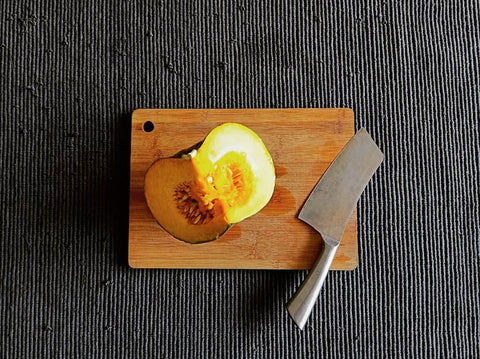
-
Don't throw the seeds out
We scoop the seeds and set them aside. They're a bit too tough to include in dishes, but they're quite nice roasted. We wash them and toss them in a little oil and salt then spread them over a baking pan. We only roast them when we have other things to broil in the oven (e.g. shiitake bacon), so we don't have to fire the oven up for just a handful of seeds. (You can also plant the seeds. We've successfully grown kalabasa vines from seed scraps.)
-
Chop the kalabasa up
We slice the kalabasa up into cubes, and cook a lot of it right away. The rest, we freeze. We also freeze what we cook, and the dishes that we cook evolve. Instant meals!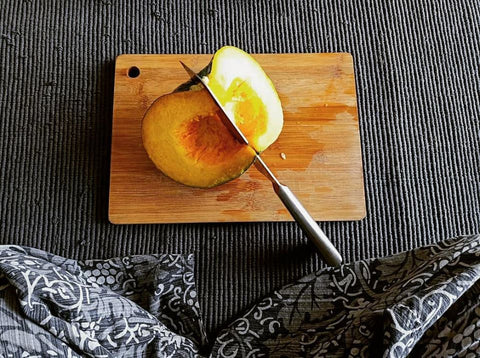
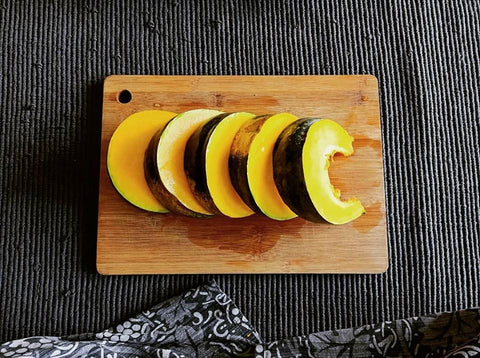
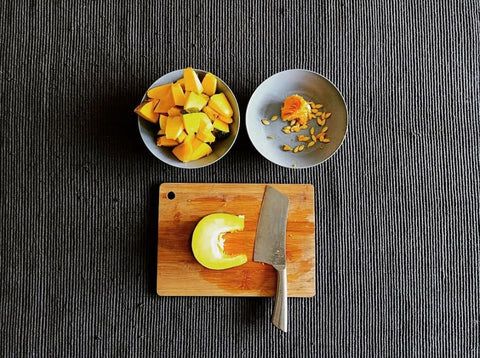
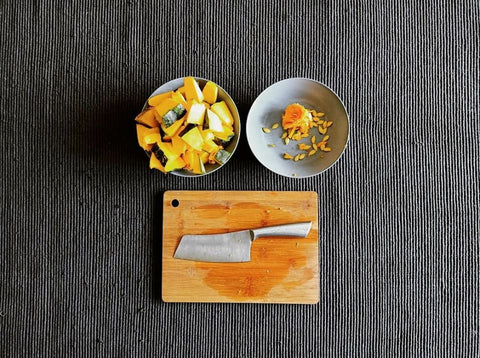
-
Freeze the kalabasa
We portion and freeze chopped up squash in glass containers or wide-mouthed jars in the freezer. Sometimes we freeze them flat on cookie trays for a hour and then scrape them into reusable silicone freezer bags. Sometimes we puree the kalabasa and freeze in portions. They last forever in the freezer. We chuck them in soups, stews, and curries as the weeks go by.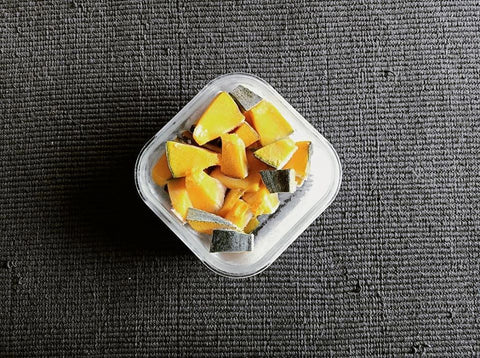
-
Save the scraps
We collect all of the pumpkin's loose odds and ends and store them in the freezer to make a broth. Learn to make your own vegetable stock by clicking here.
-
Compost whatever else
We don't usually have anything to compost, because all of our scraps wind up frozen for future use. Should you ever wind up with things you can't use for vegetable stock though (e.g. weird, rotten, mushy bits and pieces), make sure to compost them. We keep all of our organic waste from going to landfills by fermenting and composting them using Bokashi.
How do you process, prep, and store your kalabasa? Got any other pumpkin hacks? Any favourite kalabasa recipes? Show us what you've got!
__________
PS:
As with all of our posts, we are not claiming that this method is the "proper way" to do things, or even the "best way" to do things. This is simply how we do things in our home. We do a lot of research, try and test things extensively, and figure out what works for our household through experience. We hope the content we create helps cut the amount of time and effort our subscribers have to invest in learning how to shrink their own impact on the environment.
We also like to keep our minds open, and enjoy learning new things from the discussions we spur. Please feel free to share your thoughts with us? If you like this article, or think others might benefit from it, please consider sharing it and/or subscribing to our social media profiles.
#squash #kalabasa #foodprep #foodpreservation #nofoodwaste #foodwaste #zerowaste #zerowasteliving #zerowastephilippines #zerowastehome #journeytozerowaste #buhayzerowaste #druidthings #justdruidthings







